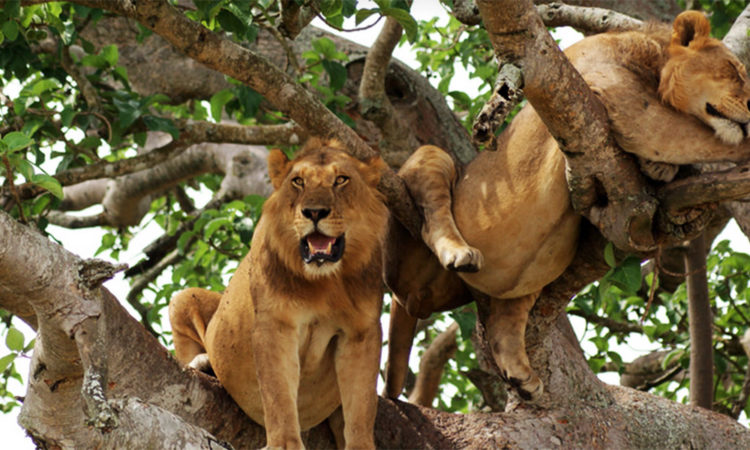Cycling tours at Queen Elizabeth National Park

Cycling tours at Queen Elizabeth National Park: Queen Elizabeth is one of Uganda’s understandable national parks and the most popular tourist destination, the park is the second largest country’s national park and was gazetted in 1952. the park is also one of the largest protected areas in Uganda, the park covers an area of approximately 1, 978 square kilometres. The park extends from lake George in the northeast to Lake Edward in the southwest and includes the Kazinga Channel connecting the two lakes. Queen Elizabeth Park is known for its wildlife viewing, including African buffalo, Ugandan Kob, hippopotamus, giant forest hog, warthog, Nile crocodile, African bush elephant, African leopard, lion, and chimpanzee. It is home to 95 mammal species and over 600 bird species. The area around Ishasha in Rukungiri District is famous for its tree-climbing lions.
For cycling enthusiasts, a cycling tour through the park offers a unique way to experience its beauty and wonders up close. Cycling tours through Queen Elizabeth National Park typically start early in the morning and late in the evening when the temperatures are cooler and the animals are most active riders will be accompanied by experienced guides who are knowledgeable about the park’s wildlife and will ensure a safe and enjoyable experience. As you pedal along the park’s winding dirt roads and park, you are rewarded with astonishing views of the wildlife such as buffaloes, elephants, Uganda Kobs, hippos, crocodiles, lions and various bird species such as White-faced whistling, red-capped robin chat, duck, fulvous whistling duck, rock’s martins, Egyptian goose, red-tailed ant thrush, garganey, Hottentot teal, hadada ibis, rufous billed heron, rufous-breasted sparrow hawk, olive woodpecker, white-tailed ant thrush, yellow-billed duck.
One of the highlights of a cycling tour through Queen Elizabeth National Park is the chance to see the famous tree-climbing lions of Ishasha. These unique lions are known for their behavior of climbing into the branches of fig trees to escape the heat and avoid insects. In addition to its wildlife, Queen Elizabeth National Park is famous for its exceptional landscape, including lush forests, rolling savannas and sparkling lakes. Cyclists will have the great opportunity to take the park’s breathtaking scenery as they ride through its winding trails.
Cycling routes at Queen Elizabeth National Park
Queen Elizabeth National Park offers several cycling routes that cater to different skill levels and interests. here are some of the popular cycling routes that visitors can explore within the park
Mweya Peninsula loop; This fascinating route takes cyclists around the Mweya peninsula, offering breathtaking views of the park’s lake such as Lake Edward and the surrounding savannah. During your cycling tour here, you will have the opportunity to spot a variety of wildlife species that dwell along the park including elephants, buffaloes, waterbuck, warthogs and several antelopes as well as colorful birds such as hadada ibis, rufous billed heron, rufous-breasted sparrow hawk, olive woodpecker, white-tailed ant thrush, yellow-billed duck among others.
Kazinga Channel ride; this route follows the Kazinga Channel, a natural waterway that connects lake Edward and Lake George, as well as a dwell to a large school of hippos. During your cycling tour along the Kazinga channel, you will be rewarded with astonishing views of the channel’s abundant birdlife such as the Great White and Pink-Backed Pelicans, African Shoebill, Yellow Billed Stork, Great and Long Tailed Cormorants, Open-Billed Stork, Saddle Bill Stork, Darters, Black Crake and Jacana as well as marveled with the fascinating view of the channel’s animals such as hippos and crocodiles basking along the shores, elephants, buffaloes among others.
Kyambura Gorge Trail; Kyambura Gorge Trail is one of the adventurous trails for cyclists. The Kyambura Gorge trail offers a challenging ride through the steep and rugged terrain. The gorge is home to chimpanzees, during your ride through the gorge trail you will be fascinated by the astonishing views of these captivating creatures in their natural habitat.
Katwe salt trail; this is one of the unique routes that takes cyclists through the Katwe Salt Lake area, where you will have the opportunity to learn about the traditional mining practices and observe the bustling activity of salt harvesting. The route also offers opportunities to spot flamingos and other colorful birds around the lake including chestnut wattle eye, white-breasted Nigro-finch, marsh tchagra, black bishop, Sulphur breasted bush shrike and many others.
Ishasha sector trail; the Ishasah sector is famous for its exceptional tree-climbing lions and this trail takes cyclists through the area where these magnificent creatures can often be seen lounging in the branches of fig trees. During your ride here, you will have the chance to encounter other wildlife species that dwell in the area such as elephants, and Uganda Kobs among others.

The cost of cycling tours at Queen Elizabeth National Park
For one to participate in this thrilling and memorable activity at Queen Elizabeth National Park, visitors are recommended to obtain or pay a fee of $30 per cyclist for foreign non-residents, $25 per cyclist for foreign residents and UGX 30, 000 per cyclist for East African citizens
What to wear when going on a cycling tour at Queen Elizabeth National Park
When planning for a cycling tour at Queen Elizabeth National Park, you should dress comfortably and appropriately for the activity. Here are some of the suggestions for what to wear
Comfortable and breathable clothing; opt for moisture-wicking materials that will help keep you dry during the ride. Avoid wearing heavy, restrictive clothing that could hinder your movement
Cycling shorts or leggings wear padded cycling or leggings for added comfort during long rides. These also help prevent chafing and offer extra cushioning
Cycling jersey; a moisture-wicking cycling jersey will help regulate your body temperature and keep you comfortable throughout the ride.
Cycling shoes; wear cycling shoes with cleats to help improve your pedaling efficiency and offer a better grip on the pedals.
Helmet; always wear a helmet to protect your head in case of any accidents or falls.
Sunglasses and sunscreen; protect yourself easily from the sun’s glare and UV rays with a pair of sunglasses
Gloves; cycling gloves can help improve your grip on the handlebars and offer padding for your hands during the long ride.
Backpack or hydration pack; Carry a small backpack or hydration pack to store water, snacks, a first aid kit and other essentials for your ride
What is the best time to go for a cycling tour at Queen Elizabeth National Park?
The best time to go for a cycling tour at Queen Elizabeth National Park is during the dry seasons, which runs from June to September and December to February. During this season, the weather is more predictable, with less rainfall and more comfortable temperatures for cycling. Additionally, the vegetation is not as dense, making it easier to spot wildlife while cycling through the park.
Other activities in Queen Elizabeth National Park
Besides a cycling tour in Queen Elizabeth National Park, the national park also offers other thrilling activities that tourists can engage in during the Uganda safari including day game drives, chimpanzee tracking, launch trips, Agro-tour Walk, cave exploration, birding, hiking and nature walks and cultural encounters among others.
Contact our trusted tour operators for more information about cycling tours in Queen Elizabeth National Park and Book with our tours and travel companies such as; Achieve Global Safari which offers the best tour packages while on your safari in Uganda.


